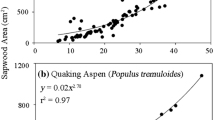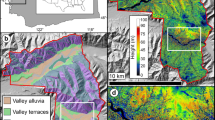Abstract
Treefall pits and mounds, formed when trees are uprooted by wind, influence an exceptionally broad range of phenomena in forests, having impacts on vegetation composition, soil formation, erosion, and soil respiration, among other processes. For example, treefall pits and mounds are known to have plant species composition with more pioneer species than nearby undisturbed soil; these microsites also are wetter (pits) or drier (mounds) than undisturbed soil; and have lower rates of soil respiration. Therefore, knowledge of the extent or coverage of these microsites will improve estimates of several processes as well as vegetation composition at the stand and landscape scale. Such information would be timely, given predictions of climate-change driven increases in severe weather that is the primary agent of pit and mound formation. However, to date, there have been no attempts to define a robust relationship to predict the sizes of these microsites across multiple forest types in eastern North America. Here, we summarize field measurement of the relationship between tree size and treefall pit and mound sizes, across ten catastrophic windthrow study sites. We find that for all ten sites pooled, simple ln–ln regression explains almost 54% of the variation in sizes of treefall pits (n = 1,039) and treefall mounds (n = 962) on the basis of tree diameter. This relationship spans numerous soil types, 31 tree species, and tree sizes ranging from 5 cm to greater than 105 cm diameter. Such a relationship may be coupled with information on the severity of disturbance (for example, proportion of stems uprooted) and pre-disturbance tree size structure, to provide a basis for predicting the area covered by pit and mound microsites at the landscape scale, and thereby a basis to frame expected impacts on soil formation, carbon cycling, vegetation establishment, and other ecological, edaphic, and biogeochemical processes.







Similar content being viewed by others
References
Amiro BD, Barr AG, Barr JG, Black TA, Bracho R, Brown M, Chen J, Clark KL, Davis KJ, Desai AR, Dore S, Engel V, Fuentes JD, Goldstein AH, Goulden ML, Kolb TE, Lavigne MB, Law, BE, Margolis HA, Martin T, McCaughey JH, Misson L, Montes-Helu M, Noormets, A, Randerson JT, Starr G, Xiao, J. 2010. Ecosystem carbon dioxide fluxes after disturbance in forests of North America. J Geophys Res 115:G00K02.
Beatty SW, Stone ER. 1986. The variety of soil microsites created by tree falls. Can J For Res 16:539–48.
Bowden RD, Castro MS, Melillo JM, Steudler PA, Aber JD. 1993. Fluxes of greenhouse gases between soils and atmosphere in a temperate forest following a simulated hurricane blowdown. Biogeochemistry 21:61–71.
Clinton BD, Baker CR. 2000. Catastrophic windthrow in the southern Appalachians: characteristics of pits and mounds and initial vegetation responses. For Ecol Manage 126:51–60.
Collins BS, Pickett STA. 1982. Vegetation composition and relation to environment in an Allegheny hardwoods forest. Am Midl Nat 108:117–23.
Cremeans DW, Kalisz PJ. 1988. Distribution and characteristics of windthrow micro-topography on the Cumberland Plateau of Kentucky. Soil Sci Soc Am J 52:816–21.
Everham EM, Brokaw NVL. 1996. Forest damage and recovery from catastrophic wind. Bot Rev 62:113–85.
Frolking, S, Palace MW, Clark DB, Chambers JQ, Shugart HH, and Hurtt GC. 2009. Forest disturbance and recovery: a general review in the context of spaceborne sensing of impacts on aboveground biomass and canopy structure. J Geophys Res 114:G00E02.
Gabet EJ, Reichman OJ, Seabloom EW. 2003. The effects of bioturbation on soil processes and sediment transport. Annu Rev Earth Planet Sci 31:249–73.
Gallaway JM, Martin YE, Johnson EA. 2009. Sediment transport due to tree root throw: integrating tree population dynamics, wildfire and geomorphic response. Earth Surf Proc Land 34:1255–69.
Harmon ME, Bond-Lamberty B, Tang J, Vargas R. 2011. Heterotrophic respiration fluxes in disturbed forests: a review with examples from North America. J Geophys Res 116:G00K04.
Harrington TB, Bluhm AA. 2001. Tree regeneration responses to microsite characteristics following a severe tornado in the Georgia Piedmont, USA. For Ecol Manage 140:265–75.
Kasischke ES, Amiro BD, Barger NN, French NHF, Goetz SJ, Grosse G, Harmon ME, Hicke JA, Liu S, Masek JG. 2013. Impacts of disturbance on the terrestrial carbon budget of North America. J Geophys Res 118(1):303–16.
Knohl A, Kolle O, Minayeva TY, Milyukova IM, Vygodskaya NN, Foken T, Schulze ED. 2002. Carbon dioxide exchange of a Russian boreal forest after disturbance by wind throw. Glob Change Biol 8:231–46.
Köster K, Puttsepp U, Pumpanen J. 2011. Comparison of soil CO2 flux between uncleared and cleared windthrow areas in Estonia and Latvia. For Ecol Manage 262:65–70.
Krueger LM, Peterson CJ. 2006. Effects of white-tailed deer on Tsuga canadensis regeneration: evidence of microsites as refugia from browsing. Am Midl Nat 156:353–62.
Küchler AW. 1964. Potential natural vegetation of the conterminous United States. New York: American Geographical Society Special Publication #36.
Lenart MT, Falk DA, Scatena FN, Osterkamp WR. 2010. Estimating soil turnover rate from tree uprooting during hurricanes in Puerto Rico. For Ecol Manage 259:1076–84.
Liu S, Bond-Lamberty B, Hicke JA, Vargas R, Zhao S, Chen J, Edburg, SL, Hu Y, Liu J, McGuire AD, Xiao J, Keane R, Yuan W, Tang, J, Luo, Y, Potter C, Oeding J. 2011. Simulating the impacts of disturbances on forest carbon cycling in North America: processes, data, models, and challenges. J Geophys Res 116:G00K08.
Lindeman JD, Baker WL. 2001. Attributes of blowdown patches from a severe wind event in the southern Rocky Mountains, USA. Landscape Ecol 16:313–25.
Lindeman JD, Baker WL. 2002. Using GIS to analyze a severe forest blowdown in the southern Rocky Mountains. Int J Geogr Inf Sci 16:377–99.
Lindroth A, Lagergren F, Grelle A, Klemedtsson L, Langvall O, Weslien P, Tuulik J. 2009. Storms can cause Europe-wide reduction in forest carbon sink. Glob Change Biol 15:346–55.
Long ZT, Carson WP, Peterson CJ. 1998. Can disturbance create refugia from herbivores: an example with hemlock regeneration on treefall mounds. J Torrey Bot Soc 125:165–8.
McIntyre CL. 1972. Soil survey of Dawson, Lumpkin and White Counties. USDA Soil Conservation Service: Georgia.
McNulty SG. 2002. Hurricane impacts on US forest carbon sequestration. Environ Pollut 116:S17–24.
Meyers NL, McSweeney K. 1995. Influence of treethrow on soil properties in northern Wisconsin. Soil Sci Soc Am J 59:871–6.
Millikin CS, Bowden RD. 1996. Soil respiration in pits and mounds following an experimental forest blowdown. Soil Sci Soc Am J 60:1951–3.
Negron-Juarez R, Baker, Zeng, H., Henkel TJ, Chambers JQ. 2010. Assessing hurricane-induced tree mortality in U.S. Gulf Coast forest ecosystems. J Geophys Res 115:G04030.
Nunez-Farfan J, Dirzo R. 1988. Within-gap spatial heterogeneity and seedling performance in a Mexican tropical forest. Oikos 51:274–84.
Peterson CJ. 2000. Damage and recovery of tree species after two different tornadoes in the same old growth forest: a comparison of infrequent wind disturbances. For Ecol Manage 135:237–52.
Peterson CJ. 2004. Within-stand variation in windthrow in southern boreal forests of Minnesota: is it predictable? Can J For Res 34:365–75.
Peterson CJ. 2007. Consistent influence of tree diameter and species on damage in nine eastern North America tornado blowdowns. For Ecol Manage 250:96–108.
Peterson CJ, Campbell JE. 1993. Microsite differences and temporal change in plant communities of treefall pits and mounds in an old-growth forest. Bull Torrey Bot Club 120:451–60.
Peterson CJ, Carson WP. 1996. Generalizing forest regeneration models: the dependence of propagule availability on disturbance history and stand size. Can J For Res 26:45–52.
Peterson CJ, Leach AD. 2008a. Limited salvage logging effects on forest regeneration after moderate-severity windthrow. Ecol Appl 18:407–20.
Peterson CJ, Leach AD. 2008b. Salvage logging after windthrow alters microsite diversity, abundance and environment, but not vegetation. Forestry 81:361–9.
Peterson CJ, Carson WP, McCarthy BC, Pickett STA. 1990. Microsite variation and soil dynamics within newly created treefall pits and mounds. Oikos 58:39–46.
Peterson CJ, Rebertus AJ. 1997. Tornado damage and initial recovery in three adjacent, lowland temperate forests in Missouri. J Veg Sci 8:559–64.
Phillips JD, Marion DA, Turkington AV. 2008. Pedologic and geomorphic impacts of a tornado blowdown event in a mixed pine-hardwood forest. Catena 75:278–87.
Putz FE. 1983. Treefall pits and mounds, buried seeds, and the importance of soil disturbance to pioneer trees on Barro Colorado Island, Panama. Ecology 64:1069–74.
Roering JJ, Marshall J, Booth AM, Mort M, Jin Q. 2010. Evidence for biotic controls on topography and soil production. Earth Planet Sci Lett 298:183–90.
Running SW. 2008. Ecosystem disturbance, carbon, and climate. Science 321:652–3.
Šamonil P, Král K, Hort L. 2010. The role of tree uprooting in soil formation: a critical literature review. Geoderma 157:65–79.
Schaetzl RJ. 1986. Complete soil profile inversion by tree uprooting. Phys Geogr 7:181–9.
Simon A, Gratzer G, Sieghardt M. 2011. The influence of windthrow microsites on tree regeneration and establishment in an old growth mountain forest. For Ecol Manage 262:1289–97.
Stephens EP. 1956. The uprooting of trees: a forest process. Soil Sci Soc Am Proc 20:113–16.
Troedsson T, Lyford WH. 1973. Biological disturbance and small-scale spatial variation in a forested soil near Garpenberg, Sweden. Stud For Suec 109:1–23.
Ulanova NG. 2000. The effects of windthrow on forests at different spatial scales: a review. For Ecol Manage 135:155–67.
U.S.D.A. Forest Service. 2001. Final Environmental Impact Statement. Boundary Waters Canoe Area Wilderness Fuel Treatment, Vol. 1. Milwaukee: U.S.D.A. Forest Service.
Vargas R, Allen MF. 2008. Diel patterns of soil respiration in a tropical forest after Hurricane Wilma. J Geophys Res 113:G03021.
Vodde F, Jogiste K, Gruson L, Ilisson T, Koster K, Stanturf JA. 2010. Regeneration in windthrow areas in hemiboreal forests: the influence of microsite on the height growths of different tree species. J For Res 15:55–64.
Walker LR. 2000. Seedling and sapling dynamics of treefall pits in Puerto Rico. Biotropica 32:262–75.
Webb SL. 1988. Windstorm damage and microsite colonization in two Minnesota forests. Can J For Res 18:1186–95.
Acknowledgments
Funding for this work was provided by grants DEB 114-3511 from the Population and Community Ecology program, and AGS 114-1926 from the Physical and Dynamic Meteorology program, of the U.S. National Science Foundation. We thank the following agencies or offices for permission to sample at the field sites: Chattahoochee National Forest, Blue Ridge Ranger District; Allegheny National Forest, Bradford Ranger District; Mingo National Wildlife Refuge; Superior National Forest; Tennessee Department of Natural Resources; and the Blooming Grove Hunting Club.
Author information
Authors and Affiliations
Corresponding author
Additional information
Author Contributions
VMS and CJP conceived the project, conducted field sampling at the Boggs Site, analyzed data, and wrote the paper; MB conducted field sampling at the Boggs Site; CJP conducted field sampling at all other sites.
Rights and permissions
About this article
Cite this article
Sobhani, V.M., Barrett, M. & Peterson, C.J. Robust Prediction of Treefall Pit and Mound Sizes from Tree Size Across 10 Forest Blowdowns in Eastern North America. Ecosystems 17, 837–850 (2014). https://doi.org/10.1007/s10021-014-9762-8
Received:
Accepted:
Published:
Issue Date:
DOI: https://doi.org/10.1007/s10021-014-9762-8




